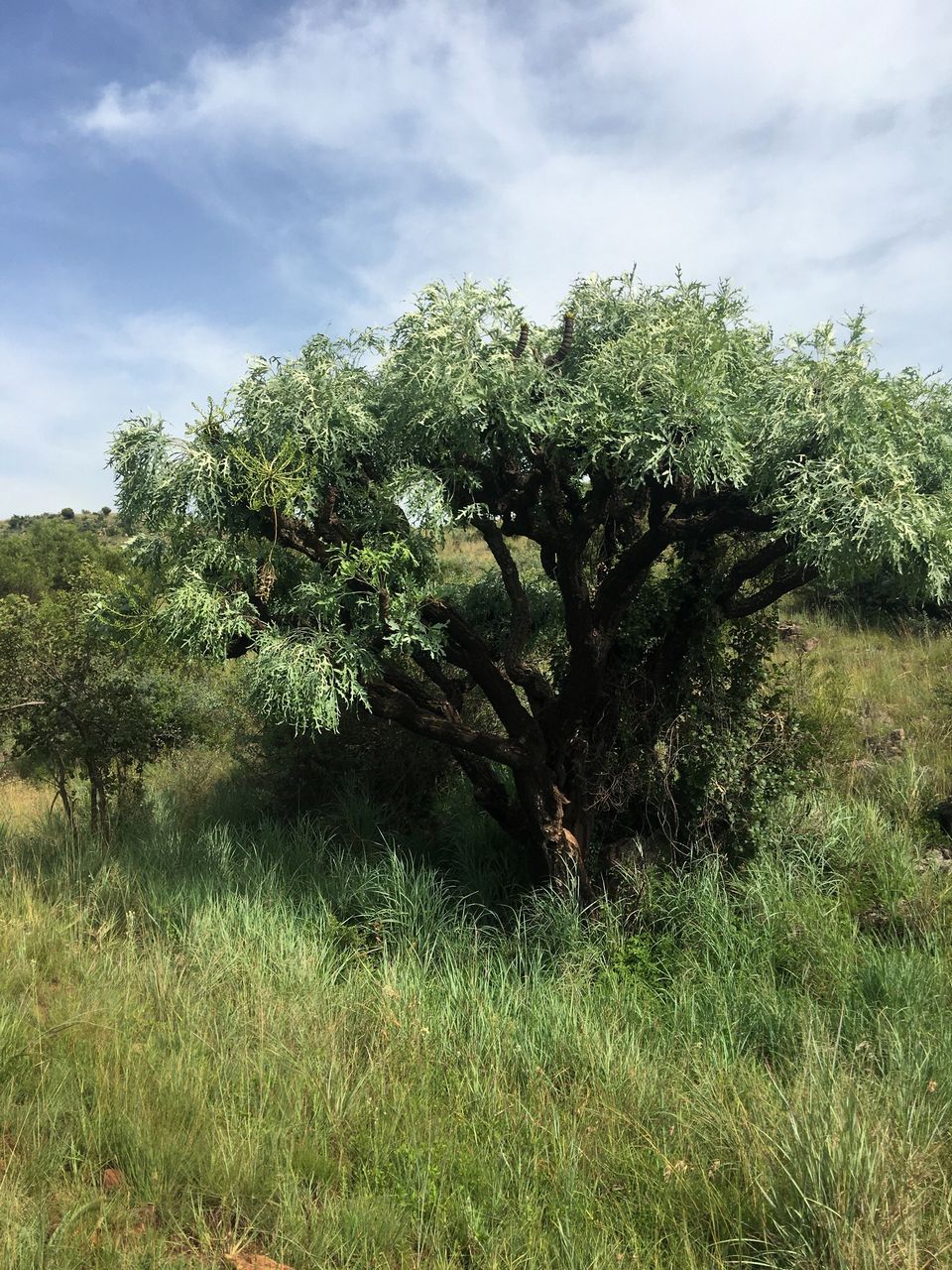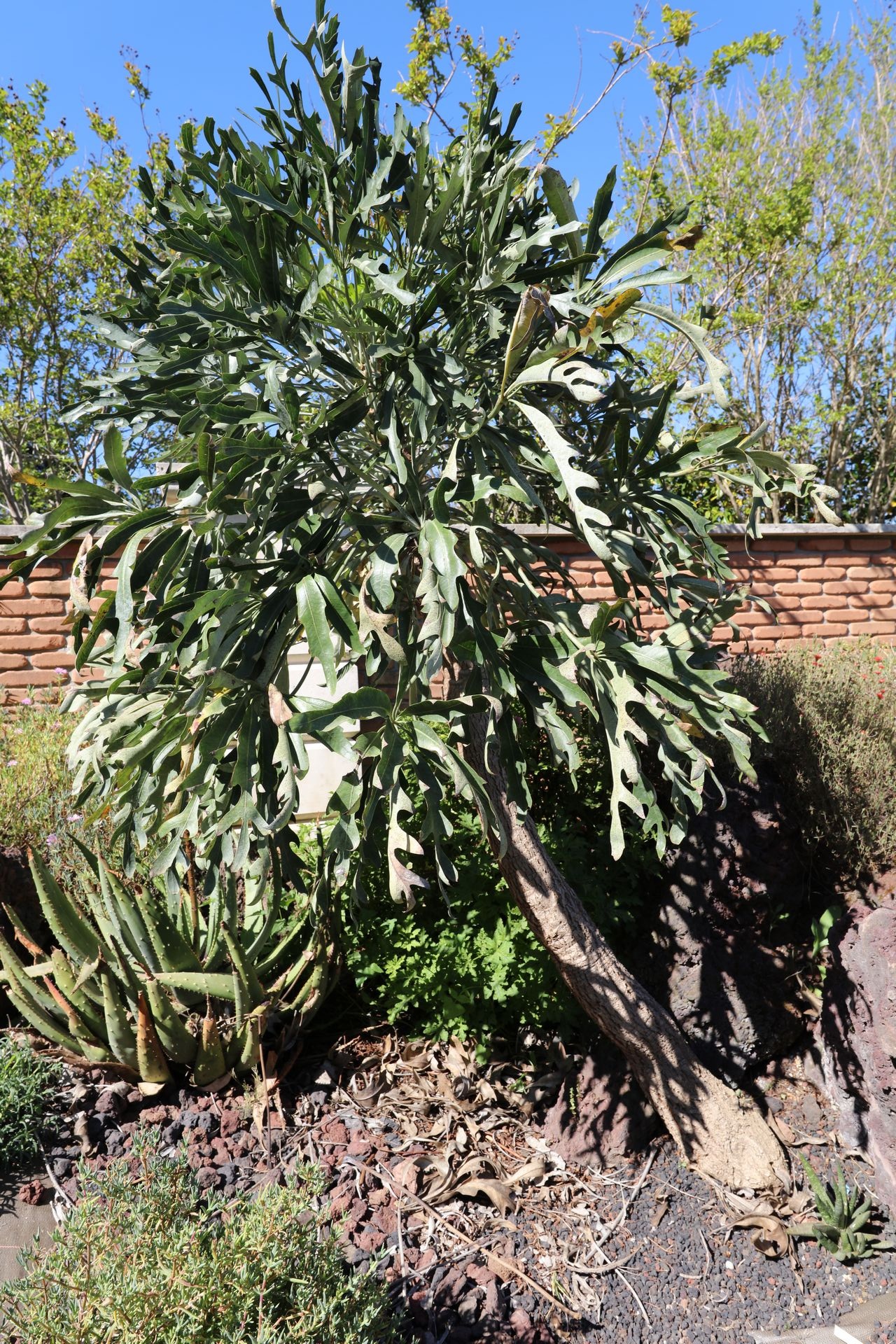Cussonia paniculata ssp sinuata 3994
Author: (William Frederick Reyneke (1945-) & Peter Daniel François Kok (1944-)) Bernard De Winter (1924-)Family: Araliaceae Subfamily: Aralioideae
Genus: Cussonia
English name: Mountain cabbage tree
Zone: South Africa
Description
Cussonia paniculata ranges from south-eastern Botswana, through the Transvaal, Swaziland, Orange Free State, Natal, and Lesotho to about as far west as Beaufort West in the Cape Province of South Africa, seldom growing below 700m altitude. It is said that it is a distinctly tree-veld species, and does not occur in close bush at all. Around Ladysmith and Pretoria it is very abundant on rocky hillsides. In the former district the hillsides and slopes of the valleys are frequently strewn with large boulders, which become intensely hot during the day, and must radiate a considerable amount of heat. The temperature in these valleys is very high, and they present a very arid and decidedly xerophytic appearance. Aloes are common on many of these slopes, and Cussonia paniculata appears to thrive. It is certainly commoner here than in the cooler, moister regions higher in the Drakensberg. Sinuata comes from Latin and means strongly waved, which refers to the leaf margins.

Cussonia paniculata ssp sinuata Observed in South Africa by Howard Geach (license)
Botanical Description
This short, thickset, often little-branched tree with a rounded crown is up to 5m high and has a diameter of up to 0,6m. The few branches have prominent leaf scars. The thick, corky trunk is rough, grey-brown and becomes deeply longitudinally fissured. This plant is pachycaul (has a disproportionately thick trunk for its height. The roots are thick and swollen.
These trees are only deciduous in cold areas. The leaves are pale blue to grey-green, up to 60cm long and are concentrated at the ends of branches where they appear mop-like. The younger leaves are a lighter green. The leaves are palmate (compound leaves that are lobed, divided or ribbed in a palm-like or hand-like fashion with leaflets arising from a single point). Each mature leaf has between 7 and 13 leaflets, which are glabrous (hairless) with a thick protective waxy covering. The leathery leaflets are up to 30 x 6cm. The margin is shallowly or deeply lobed but these constrictions do not cut to the midrib. The attenuate (showing a long gradual taper) apex tapers to a sharp tip and the base tapers. The long petiole (leaf stalk) is up to 50cm in length. It is slender with a wide base. The petiolules are up to 3cm long. The stipules (basal appendages of the petiole) are present.
The small (about 6mm in diameter), greenish yellow flowers are located in dense cylindrical raceme-like spikes. Each spike of flowers is up to 13cm long. The spikes are themselves gathered in groups of round panicles. The calyx has 5 toothed or almost entire sepals. There are 5 petals present in each flower. In the bud, their edges meet but do not overlap. The 5 stamens each have anthers with 2 thecae. These anthers are shorter than their filaments. There is a single pistil (a unit of the Gynoecium, the female element of the flower). It is composed of a 2-locular, inferior Ovary that has 2 Styles and Stigmas.
The fleshy fruit is globose and 2 carpels (each carpel is one of the foliar units of a compound pistil or ovary) are present. The fruit is up to 6mm in diameter and turns from green to purple or maroon when mature. The fruit are closely crowded along the spikes. Ripe seeds are black and, in cross section, are planoconvex (four sides: flat base, curved opposite side and 2 short sides).
These trees are only deciduous in cold areas. The leaves are pale blue to grey-green, up to 60cm long and are concentrated at the ends of branches where they appear mop-like. The younger leaves are a lighter green. The leaves are palmate (compound leaves that are lobed, divided or ribbed in a palm-like or hand-like fashion with leaflets arising from a single point). Each mature leaf has between 7 and 13 leaflets, which are glabrous (hairless) with a thick protective waxy covering. The leathery leaflets are up to 30 x 6cm. The margin is shallowly or deeply lobed but these constrictions do not cut to the midrib. The attenuate (showing a long gradual taper) apex tapers to a sharp tip and the base tapers. The long petiole (leaf stalk) is up to 50cm in length. It is slender with a wide base. The petiolules are up to 3cm long. The stipules (basal appendages of the petiole) are present.
The small (about 6mm in diameter), greenish yellow flowers are located in dense cylindrical raceme-like spikes. Each spike of flowers is up to 13cm long. The spikes are themselves gathered in groups of round panicles. The calyx has 5 toothed or almost entire sepals. There are 5 petals present in each flower. In the bud, their edges meet but do not overlap. The 5 stamens each have anthers with 2 thecae. These anthers are shorter than their filaments. There is a single pistil (a unit of the Gynoecium, the female element of the flower). It is composed of a 2-locular, inferior Ovary that has 2 Styles and Stigmas.
The fleshy fruit is globose and 2 carpels (each carpel is one of the foliar units of a compound pistil or ovary) are present. The fruit is up to 6mm in diameter and turns from green to purple or maroon when mature. The fruit are closely crowded along the spikes. Ripe seeds are black and, in cross section, are planoconvex (four sides: flat base, curved opposite side and 2 short sides).

Useful plant
The soft, whitish wood was once used for making brake pads for wagons. Leaves are good fodder for domestic herbivores, especially goats.
References
- Indigenous Plants A South Africa Guide, Pitta Joffe & Tinus Oberholzer. 2012 pag. 236. ISBN
References
- Indigenous Plants A South Africa Guide, Pitta Joffe & Tinus Oberholzer. 2012 pag. 236. ISBN

References for the genus
- Notes on the genus Cussonia in South Africa, Strey, RG. Bothalia 1973 Vol. 11(1/2) pag. 191-201. Address
General specifications
Biological type: tree
Frost resistance: 18ºF
Leaf color: glaucous
Flower color: yellow
Specifications for the Mediterranean basin
Adult size (h x w): 16,4ft x 16,4ft
Sun exposure: part sun (Sun hours: >3h <6h Foliage: evergreen
Growth: slow
Flowering time from May until November
Specific information for our garden
Planting substrate: 30%Compost+30%Coco+40%Sand
Plant watering: 3x a week pH 6.5
Logical sequence of containers for: Succulents; tray, 1L container, 2L forestry pot, 6L container, 55L container
Units in the garden: 5x
Ecology in its country of origin
Rainfall: 600-1500mm
Gravelly soil: much
Frost resistance: 18ºF
Leaf color: glaucous
Flower color: yellow
Specifications for the Mediterranean basin
Adult size (h x w): 16,4ft x 16,4ft
Sun exposure: part sun (Sun hours: >3h <6h Foliage: evergreen
Growth: slow
Flowering time from May until November
Specific information for our garden
Planting substrate: 30%Compost+30%Coco+40%Sand
Plant watering: 3x a week pH 6.5
Logical sequence of containers for: Succulents; tray, 1L container, 2L forestry pot, 6L container, 55L container
Units in the garden: 5x
Ecology in its country of origin
Rainfall: 600-1500mm
Gravelly soil: much
Experiences in the garden
12-05-16A Obtaining 6 plants from nursery Issa, they are planted in zone(s) PlatBAizo
12-11-19 1x Dead plant because of frost: Terras1d C12.